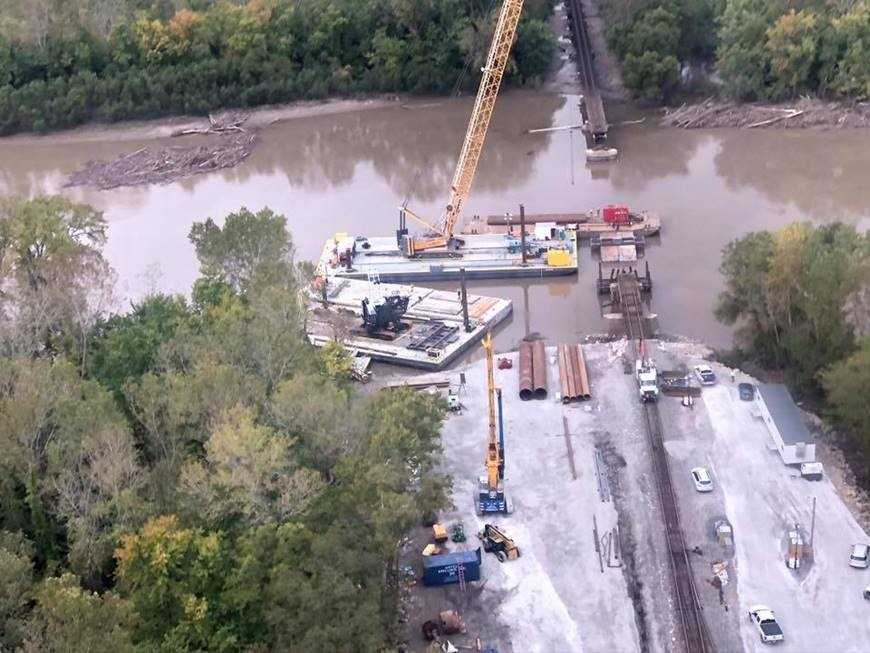But after a year of extraordinary challenges, Monday’s presentations by Norfolk Southern and Union Pacific each spent significant time acknowledging those contractors’ extraordinary efforts in restoring service after major floods in 2019.
For David Becker, NS’s chief engineer, design and construction, that meant highlighting work to restore the bridge over the Grand River near Moberly, Mo., wiped out by debris flow on Oct. 1.
The debris knocked out 270 feet of bridge deck on a 1930s-vintage, 1,000-foot structure.
The bridge survived one previous round of flooding in May, when an estimated 10 acres of debris had backed up against the 600 feet of the main span. Crews worked then for days to remove the drift and preserve the structure with no damage.
At 7 a.m. on Oct. 1, a train crossing the bridge reported rough track, inspections found the bridge had been knocked 8 inches out of alignment. Later in the day, the structure finally gave way. But 27 days later, service was restored, thanks to 20,000 man-hours of work. The effort will be honored on Wednesday with the NRC’s Small Project of the Year award.
Eric Gehringer, Union Pacific’s vice president of engineering, noted that eight subdivisions on his railroad’s 90-train-a-day Central Corridor and connecting routes were wiped out in a little over two weeks.
To illustrate the power of the forces at work, he noted a bridge that was wiped out on the Falls City Subdivision, where three piers and four spans were washed out.
“The piers on that bridge are 80 feet deep,” he said, “and we still can’t find two of them. Even now that the water’s down and you can literally walk across this river. … A tremendous amount of soil came down that river, moved those piers, and then buried them again, probably 60 feet underground.”
Gehringer highlighted work to restore service after flooding on the railroad’s Columbus Subdivision between Fremont and Grand Island, Neb., which he called “the epicenter of what Mother Nature did to us.”
In one stretch, the double-track route was buried under 10 feet of silt with a gelatinous consistency.
“You start to ask yourself, what’s the pros and cons of building on that. You know it’s going to be an unstable environment,” he said. “This river normally is like 400 feet wide. When the flooding occurred, it was 7,200 feet wide.”
Before starting repairs on the right-of-way, the railroad had to repair a two-mile access road.
“You wouldn’t think that’s that hard,” he said. “But when you just had a 7,200-foot river go through it, destroying everything in its path and bringing in millions of tons of sand, it was a massive challenge. Just to get the road open, we had 510 rock trucks cycling 24 hours a day.”
Once the road was opened, repair crews brought in timber from Wisconsin and Colorado and built a timber road across the site. At another spot, rock had to be used to fill a 40-foot hole. The rock trucks worked for seven days, followed by 10 days where rock and ballast was brought in by train.
“For any of you who have been to our Omaha headquarters, you might recall when you walk in there’s a massive atrium, 19 stories tall,” Gehringer said. “The amount of rock we brought in would fill that entire atrium.”
In all, 133,000 tons of material were needed to fill that hole.
As for the 2020 plans:
— NS will complete three capacity projects begun in 2019 (a siding in Leighton, Ala.; turnout upgrades in Cincinnati; and a yard to support a new Mazda-Toyota plant in Huntville, Ala.) and facility projects at four Chicago intermodal facilities (Calumet Yard, Landers Yard, 47th Street, and 63rd Street). Becker said most investments will be aimed at supporting longer trains on the railroad’s Chicago-Atlanta route via Cincinnati, and lines serving southeastern ports.
— Union Pacific will not complete its capital budget until February. The railroad spent $1.92 billion on its infrastructure in in 2019, in line with its spending in each of the previous four years. In 2020, it projects replacing 3.5 million ties on 3,700 miles of trackage, 450 track-miles of rail, and 3.6 miles of bridges and 3.2 miles of bridge deck. Major capacity projects will include continued work to build out its network to handle 15,000-foot trains on its Sunset Corridor between Los Angeles and Santa Teresa, N.M., and on the three routes (Golden State, T&P, and Del Rio) radiating eastward from Santa Teresa.














